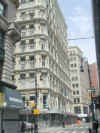 |
New York
Architecture Images-Seaport and Civic Center Bennet Building Landmark |
|
architect |
Arthur D. Gilman |
|
location |
93-99 Nassau St. |
|
date |
1873 Additions 1892-4 James M. Farnsworth. |
|
style |
Second Empire Baroque (esp. before mansard roof was removed). |
|
construction |
|
|
type |
Office-Cast Iron Facade |
|
|
|
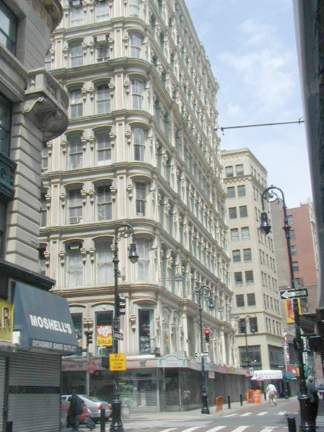 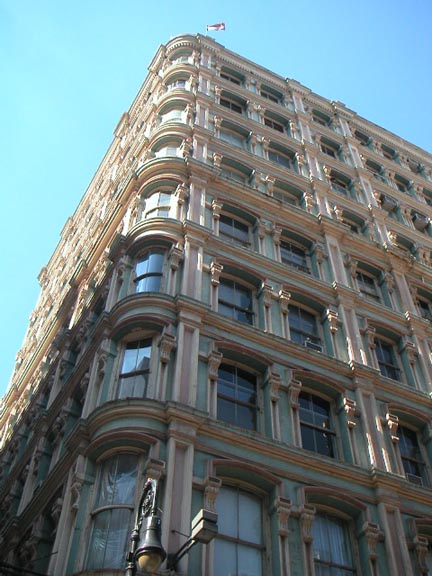 |
|
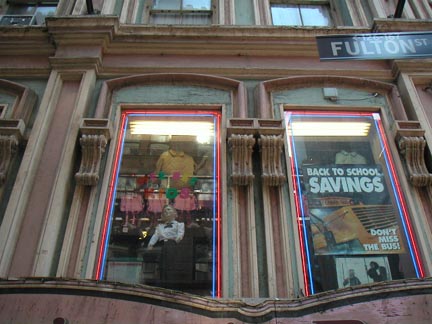 |
|
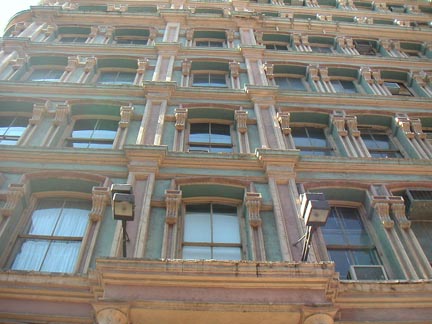 |
|
|
notes |
Landmarks
Preservation Commission November 21, 1995; Designation List 269 LP-1937 Bennett Building, 139 Fulton Street (aka 135-139 Fulton Street, 93-99 Nassau Street, 28-34 Ann Street), Manhattan. Built 1872-73, Arthur D. Gilman, architect; addition 1890-92 and 1894, James M. Farnsworth, architect. The Bennett Building, constructed in 1872-73 and enlarged in 1890-92 and 1894, is a major monument to the art of cast-iron architecture. Ten stories high with three fully designed facades fronting Fulton, Nassau, and Ann Streets, it has been described as the tallest habitable building with cast-iron facades ever built. Commissioned as a real estate investment by James Gordon Bennett, Jr., the publish of the New York Herald newspaper, the Bennett Building was originally a six-story French Second Empire structure. Designed by the prominent architect Arthur D. Gilman, whose Boston City Hall was instrumental in popularizing the Second Empire style in America, the Bennett Building appears to be the architect's only extant work in the style in New York. Gilman was also an important pioneer in the development of the office building, and the Bennett Building is the sole survivor among the major office buildings he designed. Second Empire office buildings flourished in Lower Manhattan after the Civil War; this is one of two such buildings with cast-iron fronts still standing south of Canal Street. In 1889, the Bennett building was acquired by John Pettit, a leading real estate investor who commissioned architect James M Farnsworth to enlarge the building to its present size. Source: Landmarks Preservation Commission Report STREETSCAPES/ The Bennett Building N.Y. Times. January 7.1996 (Real Estate-Section 9) A Multicolored Cast-Iron Confection 10-floor Nassau St. Building may be the tallest of its type. By CHRISTOPHER GRAY Now it is lost among the retail pandemonium of Upper Nassau Street. But the Bennett Building, on the west side of Nassau between Fulton and Ann Street, was once one of New York’s notable skyscrapers and is perhaps the tallest cast-iron building in the world. So last November the Landmarks Preservation Commission made it one of New York’s newest landmarks, to the resigned dismay of its lessee. In the late 1860’s James Gordon Bennett Jr., took over the management of The New York Herald from his father, who had founded it on a shoestring in 1835. The newspaper had recently vacated its old location at the northwest corner of Nassau and Fulton Streets for a new building on Broadway and in 1872 the younger Bennett filed plans for a new structure on the old site, seven stories capped by a mansard roof. Completed in1873, it was not the tallest building in the city. But the size of the operation – 292 front feet on three streets – made it one of the most prominent. Designed by Arthur D.Gilman, the facade is heavy with repetition, like most other cast- iron buildings of its period, although the architect avoided the column-on-top-of-column format common at the time. An advertisement in The Herald in 1873 showed plans of typical floors with offices ranging from 26 to 67 feet down to mere cubicles that could be rented separately or thrown together. The Bennett Building had two large stairways an two elevators. It is known that upper-floor space in walk-up buildings rented for substantially less money than that on lower floors, but architecture historians are not clear on what happened when the elevator made all floors relatively equal. In the Bennett Building, at least, The Herald published a figure of $125 ,000 for the yearly rent roll :$22,500 for the ground floor, $40,000 for the main floor (designed for a banking office), $20,000 for the second, $15,000 for the third, $12,500 for the fourth, $10,000 for the fifth and $5,000 for the sixth, the one enclosed by the mansard. Apparently the elevator did not instantly erase the prejudice against height. Bennett was flamboyant and unpredictable in his personal and professional life . Just before he built the Bennett Building, he financed Henry Stanley’s expedition to Africa in search of David Livingston, and he was active in the worlds of yachting, trap shooting and polo. Early in 1877, engaged to Caroline May, he committed some indiscretion while inebriated and subsequently survived a duel with her brother, Frederick, over the matter. Unmarried, Bennet moved to France, where he started a Paris edition of The Herald, which survives today as The International Herald Tribune. The Nassau Street Building was simply an investment for Bennett. In an 1882 article found by Gale Harris, who wrote the designation report for the Landmarks Preservation Commission, the Real Estate Record & Guide judged him " a little too previous " in building at that scale in that location, close neither to Wall Street nor to the courts. Bennett sold the structure in 1889 and in the 1890’s a new owner first added three floors and then a matching, 25-foot-wide bay on Ann Street, all in cast iron. The rebuilt structure is 10 full floors. In the 1980’s Edward Haddad repainted his Bennett Building in the present amusing scheme – aqua, cream and pink, like an ice-cream parlor at Disneyland. He sold the building last year to the ENT Realty Corporation, which has net leased it to a group headed by Robert Galpern. It was Mr Galpern who appeared at the landmarks hearing last September to protest . " It’s a form of taking , " he says, concerned that basic repairs will be slowed in another layer of review. But preservation groups, rallied by the activist Margot Gayle, who called the building a " unique piece of American architecture, " showed up in force. " We felt so powerless " says Mr.Galpern. " There was only 10 minutes of discussion for Donald Trump’s building at 40 Wall Street, " he said referring to the skyscraper that was planned as the tallest in the world. " But for us there were 25 speakers. " |
|
links |